Many trade books in different genres can enrich content area learning in classrooms at all grade levels. The books in this week’s column provide unique perspectives on topics in science and social studies. We were excited by the lively, vigorous, and imaginative approaches of the books, which evoke wonder and discovery and invite discussion and further exploration of the topics they introduce.
Ages 4–8
Animal Ark: Celebrating Our Wild World in Poetry and Pictures. Kwame Alexander (with Mary Rand Hess & Deanna Nikaido). Ill. Joel Sartore. 2017. National Geographic Kids.
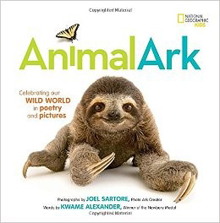 This collaboration celebrating the diversity of our wild world presents large-format photographs of animals from around the world such as the St. Andrews beach mouse, bobtail squid, African leopard, and Bengal slow loris. Photographs, common names, locations, and endangered status of the featured animals and other animals in Sartore’s Photo Ark project appear in a foldout in the back matter. The book has two additional foldouts of animal portraits. The center double-page foldout features a longer poem, “The Chorus of Creatures,” that celebrates connections between humans and the world’s wild animals, ending with “Listen to the earth. / That sound you hear / is hope with wings.” The arresting photographs show some animals seeming to be as curious about the reader as readers will be about the animals. Back matter includes notes from Sartore and Alexander.
This collaboration celebrating the diversity of our wild world presents large-format photographs of animals from around the world such as the St. Andrews beach mouse, bobtail squid, African leopard, and Bengal slow loris. Photographs, common names, locations, and endangered status of the featured animals and other animals in Sartore’s Photo Ark project appear in a foldout in the back matter. The book has two additional foldouts of animal portraits. The center double-page foldout features a longer poem, “The Chorus of Creatures,” that celebrates connections between humans and the world’s wild animals, ending with “Listen to the earth. / That sound you hear / is hope with wings.” The arresting photographs show some animals seeming to be as curious about the reader as readers will be about the animals. Back matter includes notes from Sartore and Alexander.
—SW
Rivers of Sunlight: How the Sun Moves Water Around the Earth. (The Sunlight Series). Molly Bang and Penny Chisholm. Ill. Molly Bang. 2017. Blue Sky/Scholastic.
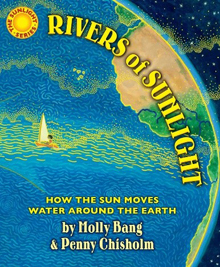 With the same combination of expressive text and stunning illustrations used in the first four books in the Sunlight Series, Molly Bang and Penny Chisholm present an accessible scientific explanation of “how the sun moves water around the earth.” The sun is the narrator. Key points in the sun’s explanation, highlighted in yellow print, include statements such as “Almost all of Earth’s water is in your salty seas” and “This is the Gulf Stream—part of the enormous ocean river.” The text ends with the sun’s promise to do its part to keep Earth’s water clean and flowing and a call for readers to do their part to use water sparingly and keep it clean. Extensive endnotes provide more details.
With the same combination of expressive text and stunning illustrations used in the first four books in the Sunlight Series, Molly Bang and Penny Chisholm present an accessible scientific explanation of “how the sun moves water around the earth.” The sun is the narrator. Key points in the sun’s explanation, highlighted in yellow print, include statements such as “Almost all of Earth’s water is in your salty seas” and “This is the Gulf Stream—part of the enormous ocean river.” The text ends with the sun’s promise to do its part to keep Earth’s water clean and flowing and a call for readers to do their part to use water sparingly and keep it clean. Extensive endnotes provide more details.
—CA
Thirsty, Thirsty Elephants. Sandra Markle. Ill. Fabricio VandenBroeck. 2017. Charlesbridge.
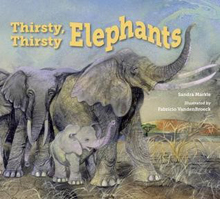 When a severe drought in Tanzania dries up their local water holes, Grandma Elephant sets out with her herd in search of a plentiful source of water. Little Calf suffers greatly from the heat and lack of water during the long trek before Grandma’s trumpeting signals that she has found the watering hole remembered from a “thirsty, thirsty time long ago” when she was the size of Little Calf. VandenBroeck’s mixed-media illustrations beautifully detail the setting and express the close and caring relationships of the elephants. Back matter includes an author’s note on the inspiration for the book—the true story of an older elephant (named Big Mama by researchers) who saved her herd during a long drought in 1994; a list of amazing elephant facts; and a list of resources.
When a severe drought in Tanzania dries up their local water holes, Grandma Elephant sets out with her herd in search of a plentiful source of water. Little Calf suffers greatly from the heat and lack of water during the long trek before Grandma’s trumpeting signals that she has found the watering hole remembered from a “thirsty, thirsty time long ago” when she was the size of Little Calf. VandenBroeck’s mixed-media illustrations beautifully detail the setting and express the close and caring relationships of the elephants. Back matter includes an author’s note on the inspiration for the book—the true story of an older elephant (named Big Mama by researchers) who saved her herd during a long drought in 1994; a list of amazing elephant facts; and a list of resources.
—CA
The Tree. Neal Layton. 2017. Candlewick.
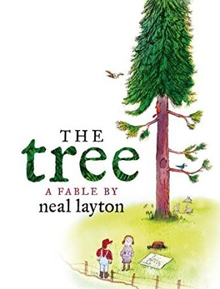 A few large-type words on verso pages—“A tree / a birds’ nest / a squirrels’ nest, an owls’ hollow / and a rabbits’ burrow”—and pen-and-watercolor wash illustrations on the recto pages set the scene of a lone evergreen standing on a small, fenced-in plot and introduce the animals for whom the tree is home. New arrivals, a man and a woman, come with blueprints and building materials. As they saw down the tree, a falling birds’ nest and fleeing creatures surprise them. The couple makes a change of plans that results in “a happy home” for all. Layton’s fable offers a simple, thought-provoking message on humans sharing the natural environment with other species.
A few large-type words on verso pages—“A tree / a birds’ nest / a squirrels’ nest, an owls’ hollow / and a rabbits’ burrow”—and pen-and-watercolor wash illustrations on the recto pages set the scene of a lone evergreen standing on a small, fenced-in plot and introduce the animals for whom the tree is home. New arrivals, a man and a woman, come with blueprints and building materials. As they saw down the tree, a falling birds’ nest and fleeing creatures surprise them. The couple makes a change of plans that results in “a happy home” for all. Layton’s fable offers a simple, thought-provoking message on humans sharing the natural environment with other species.
—CA
Ages 9-11
Gorilla Dawn. Gill Lewis. Ill. Susan Meyer. 2017. Caitlyn Dlouhy/Atheneum/Simon & Schuster.
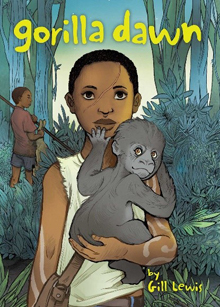 A baby gorilla is captured by rebel soldiers and taken to their illegal mining camp within the boundaries of a national park in the Democratic Republic of Congo. Two children set out to free the gorilla after learning that he is to be sold and smuggled out of the country. Imara is an enslaved girl who has survived by convincing Black Mamba, the leader of the rebel guerillas, that she is a Spirit Child with supernatural powers to protect him. Bobo is the son of a wildlife ranger accused of killing the leader of the gorilla troop, who has joined the rebels to find proof of his father’s innocence. An author’s note provides information on the endangered status of the eastern lowland gorilla and conservation efforts to protect the gorilla and rainforest of the Congo.
A baby gorilla is captured by rebel soldiers and taken to their illegal mining camp within the boundaries of a national park in the Democratic Republic of Congo. Two children set out to free the gorilla after learning that he is to be sold and smuggled out of the country. Imara is an enslaved girl who has survived by convincing Black Mamba, the leader of the rebel guerillas, that she is a Spirit Child with supernatural powers to protect him. Bobo is the son of a wildlife ranger accused of killing the leader of the gorilla troop, who has joined the rebels to find proof of his father’s innocence. An author’s note provides information on the endangered status of the eastern lowland gorilla and conservation efforts to protect the gorilla and rainforest of the Congo.
—CA
Lesser Spotted Animals: The Coolest Creatures You’ve Never Heard Of. Martin Brown. 2017. David Fickling/Scholastic.
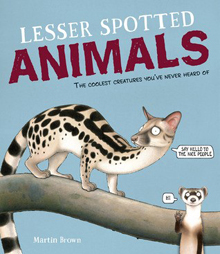 In the introduction, Brown sets the tone for this book with his “good-bye to the gnu and cherrio to the cheetah.” Each mammal (zorilla, long-tailed dunnart, onager, gaur, zebra duiker, and 16 more) is given a double spread: a heading with common name and an interest-catching identification (e.g., “CUBON SOLENODON Shaggy Caribbean insectivore with a toxic bite”), a realistic portrait, and information about its characteristics and behavior. An inset provides information about the animal’s size, what it eats, where it lives, its status, and a bit of trivia. Backmatter includes a glossary and a chart on the grading of status from least concern (no need to worry at present) to extinct (gone) as well as data deficient (not enough is known to judge).
In the introduction, Brown sets the tone for this book with his “good-bye to the gnu and cherrio to the cheetah.” Each mammal (zorilla, long-tailed dunnart, onager, gaur, zebra duiker, and 16 more) is given a double spread: a heading with common name and an interest-catching identification (e.g., “CUBON SOLENODON Shaggy Caribbean insectivore with a toxic bite”), a realistic portrait, and information about its characteristics and behavior. An inset provides information about the animal’s size, what it eats, where it lives, its status, and a bit of trivia. Backmatter includes a glossary and a chart on the grading of status from least concern (no need to worry at present) to extinct (gone) as well as data deficient (not enough is known to judge).
—CA
The Secret Project. Jonah Winter. Ill. Jeanette Winter. 2017. Beach Lane/Simon & Schuster.
 Jonah Winter’s spare text—“In the beginning, there was just a peaceful desert mountain landscape….”— and Jeanette Winter’s flat folk art–style acrylic paintings present a picture-book history of the secret project that brought scientists to a remote site in New Mexico in 1943 to develop an atomic bomb. The deep secrecy of the project is expressed in the contrast between the detailed and richly colored desert landscape and the gray-black silhouettes of the “shadowy figures” (the researchers) working day and night. Following the countdown for the testing of the bomb are four wordless pages showing stages of the explosion—and a startling black final double spread. An author’s note provides additional information answering some of the questions that reading The Secret Project will raise.
Jonah Winter’s spare text—“In the beginning, there was just a peaceful desert mountain landscape….”— and Jeanette Winter’s flat folk art–style acrylic paintings present a picture-book history of the secret project that brought scientists to a remote site in New Mexico in 1943 to develop an atomic bomb. The deep secrecy of the project is expressed in the contrast between the detailed and richly colored desert landscape and the gray-black silhouettes of the “shadowy figures” (the researchers) working day and night. Following the countdown for the testing of the bomb are four wordless pages showing stages of the explosion—and a startling black final double spread. An author’s note provides additional information answering some of the questions that reading The Secret Project will raise.
—CA
Soldier Song: A True Story of the Civil War. Debbie Levy. Ill. Gilbert Ford. 2017. Disney Hyperion.
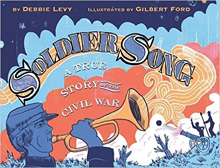 At the Battle of Fredericksburg in 1863, after being defeated by the Confederate Army, the Union Army stole across the river and both armies settled in to nurse the wounded and regroup. Illustrations, in the style of silkscreen and woodblock prints in soft hues of blue, purple, and green, depict the following days in which pipers and buglers played songs heard on both sides of the river, reminding the soldiers of their common culture in music. The singing in unison of a song of longing and hope, “Home Sweet Home,” buoyed their spirits through cold, rainy days. Orange flourishes show the music wafting between the two sides. Excerpts from primary sources, including letters and diaries, add detail to the pages. The extensive backmatter includes a timeline, historical notes, short biographies of individuals at Fredericksburg, a history and score of “Home Sweet Home,” source notes, and references.
At the Battle of Fredericksburg in 1863, after being defeated by the Confederate Army, the Union Army stole across the river and both armies settled in to nurse the wounded and regroup. Illustrations, in the style of silkscreen and woodblock prints in soft hues of blue, purple, and green, depict the following days in which pipers and buglers played songs heard on both sides of the river, reminding the soldiers of their common culture in music. The singing in unison of a song of longing and hope, “Home Sweet Home,” buoyed their spirits through cold, rainy days. Orange flourishes show the music wafting between the two sides. Excerpts from primary sources, including letters and diaries, add detail to the pages. The extensive backmatter includes a timeline, historical notes, short biographies of individuals at Fredericksburg, a history and score of “Home Sweet Home,” source notes, and references.
—SW
Ages 12–14
Me and Marvin Gardens. Amy Sarig King. 2017. Scholastic.
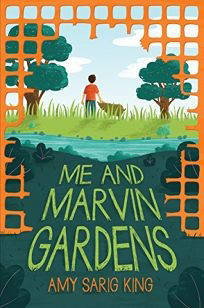 Eleven-year-old Obe Devlin loves the creek that runs through the small bit of land still owned by his family after his alcoholic great-great-grandfather mortgaged and lost most of the Devlin farmland over 100 years ago. The once-Devlin acreage has become a huge housing development. While collecting trash along the creek, Obe comes across a strange creature that eats plastic. Has he discovered a new species of animal? Could its plastic-eating habit be a solution to the pollution problems associated with nonbiodegradable plastic? He wants to keep Marvin Gardens (named after the Monopoly property) a secret, but when he discovers that Marvin’s poop is toxic and that he has a family near the river, Obe realizes that he needs help in protecting Marvin and confides in his science teacher. This is a coming-of-age story and thought-provoking fantasy about a boy with a strong sense of responsibility for the environment.
Eleven-year-old Obe Devlin loves the creek that runs through the small bit of land still owned by his family after his alcoholic great-great-grandfather mortgaged and lost most of the Devlin farmland over 100 years ago. The once-Devlin acreage has become a huge housing development. While collecting trash along the creek, Obe comes across a strange creature that eats plastic. Has he discovered a new species of animal? Could its plastic-eating habit be a solution to the pollution problems associated with nonbiodegradable plastic? He wants to keep Marvin Gardens (named after the Monopoly property) a secret, but when he discovers that Marvin’s poop is toxic and that he has a family near the river, Obe realizes that he needs help in protecting Marvin and confides in his science teacher. This is a coming-of-age story and thought-provoking fantasy about a boy with a strong sense of responsibility for the environment.
—CA
Pathfinders: The Journeys of 16 Extraordinary Black Souls. Tonya Bolden. 2017. Abrams.
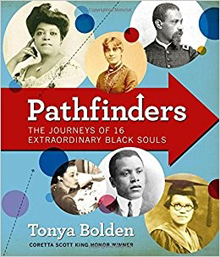 Readers are introduced chronologically to black men and women who will surprise and engage them, including a race car driver, a movie director, a concert singer, a banker, an architect, an economist and attorney who served on President Truman’s Committee on Civil Rights, and a NASA mathematician. All rose from modest backgrounds and, equipped with determination, vision, and passion for learning, made contributions to culture, commerce, and society. Each biography, written in Bolden’s engaging voice, includes sidebars, archival photographs with extensive captions, bullet points on details of their lives and families, notes on other people who had similar dreams and made similar contributions, and inserts describing the times in which they lived. Backmatter includes a glossary, source notes, bibliography, credits, and an index.
Readers are introduced chronologically to black men and women who will surprise and engage them, including a race car driver, a movie director, a concert singer, a banker, an architect, an economist and attorney who served on President Truman’s Committee on Civil Rights, and a NASA mathematician. All rose from modest backgrounds and, equipped with determination, vision, and passion for learning, made contributions to culture, commerce, and society. Each biography, written in Bolden’s engaging voice, includes sidebars, archival photographs with extensive captions, bullet points on details of their lives and families, notes on other people who had similar dreams and made similar contributions, and inserts describing the times in which they lived. Backmatter includes a glossary, source notes, bibliography, credits, and an index.
—SW
Ages 15+
Girl Rising: Changing the World One Girl at a Time. Tanya Lee Stone. 2017. Wendy Lamb/Random House.
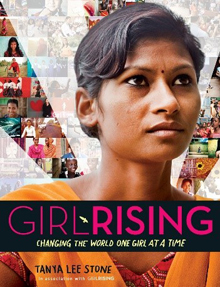 In a collection of stories of young women from around the world, Stone explores the reality of teenaged girls longing for education. Stone explores video and interviews compiled for the film Girl Rising to reveal stories of individual girls from Afghanistan, Cambodia, Egypt, Ethiopia, Haiti, India, Nepal, Peru, and Sierra Leone. In text accompanied by beautiful full-page photographs, she presents the voices of the girls who experienced slavery, rape, and forced marriage when they were not yet teenagers. The girls tell how they survived, in some cases fleeing again and again back to their families. Stone includes statistics and details about the status of millions of young women around the world and addresses resources for social action in the last section. Backmatter includes an author’s note, bibliography, source notes, and resources.
In a collection of stories of young women from around the world, Stone explores the reality of teenaged girls longing for education. Stone explores video and interviews compiled for the film Girl Rising to reveal stories of individual girls from Afghanistan, Cambodia, Egypt, Ethiopia, Haiti, India, Nepal, Peru, and Sierra Leone. In text accompanied by beautiful full-page photographs, she presents the voices of the girls who experienced slavery, rape, and forced marriage when they were not yet teenagers. The girls tell how they survived, in some cases fleeing again and again back to their families. Stone includes statistics and details about the status of millions of young women around the world and addresses resources for social action in the last section. Backmatter includes an author’s note, bibliography, source notes, and resources.
—SW
Loving vs. Virginia: A Documentary Novel of the Landmark Civil Rights Case. Patricia Hruby Powell. Ill. Shadra Strickland. 2017. Chronicle.
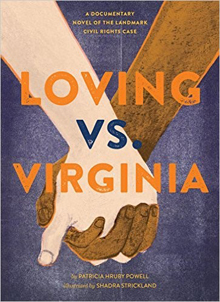 Mildred Jeter and Richard Loving grew up in Virginia. Their families were friends. Richard liked the energetic, smart, visionary Mildred. She loved her family and school and came to love him. Their story, told in verse in alternate voices, recounts their growing happiness together in the community of their families. In 1958 the interracial couple married in Washington, DC, because of Virginia’s antimiscegenation law. Upon returning to Virginia they were arrested, and so began their journey of nine years of separation from their families, during which the ACLU took up their case. This resulted in the overturning of the Lovings’ conviction by the U.S. Supreme Court on June 12, 1967. With illustrations painted in muted hues, the novel is set against events of the Civil Rights movement in the 1950s and 1960s. Back matter includes a note on Loving and Jeter; a timeline; a bibliography that includes interviews conducted by the author, written material, and credits and sources; an artist’s note; and acknowledgments.
Mildred Jeter and Richard Loving grew up in Virginia. Their families were friends. Richard liked the energetic, smart, visionary Mildred. She loved her family and school and came to love him. Their story, told in verse in alternate voices, recounts their growing happiness together in the community of their families. In 1958 the interracial couple married in Washington, DC, because of Virginia’s antimiscegenation law. Upon returning to Virginia they were arrested, and so began their journey of nine years of separation from their families, during which the ACLU took up their case. This resulted in the overturning of the Lovings’ conviction by the U.S. Supreme Court on June 12, 1967. With illustrations painted in muted hues, the novel is set against events of the Civil Rights movement in the 1950s and 1960s. Back matter includes a note on Loving and Jeter; a timeline; a bibliography that includes interviews conducted by the author, written material, and credits and sources; an artist’s note; and acknowledgments.
—SW
Tonya Bolden will be at ILA 2017 Conference & Exhibits as part of the Young Adult Putting Books to Work workshop, which takes place Monday, July 17, from 8:00 a.m. to 10:00 a.m.
Tanya Lee Stone will be one of our cohosts for the #ILAchat “Empowering Girls Through Education” on Tuesday, March 14, at 8:00 p.m. ET. Stone will also appear at ILA 2017 Conference & Exhibits, where she’ll be taking part in the Young Adult Author Meetup on Saturday, July 15, 3:00 p.m. to 5:00 p.m.
These reviews are submitted by members of the International Literacy Association's Children's Literature and Reading Special Interest Group (CL/R SIG) and are published weekly on Literacy Daily.
Sandip Wilson serves as associate professor in the College of Health and Education of Husson University in Bangor, ME. Carolyn Angus is former Director of the George G. Stone Center for Children's Books, Claremont Graduate University, CA.
These reviews are submitted by members of the International Literacy Association's Children's Literature and Reading Special Interest Group (CL/R SIG) and are published weekly on Literacy Daily
.